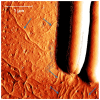Clostridioides difficile Flagella
- PMID: 38396876
- PMCID: PMC10889297
- DOI: 10.3390/ijms25042202
Clostridioides difficile Flagella
Abstract
Clostridioides difficile is an important pathogen for humans with a lead in nosocomial infection, but it is also more and more common in communities. Our knowledge of the pathology has historically been focused on the toxins produced by the bacteria that remain its major virulence factors. But the dysbiosis of the intestinal microbiota creating the conditions for the colonization appears to be fundamental for our understanding of the disease. Colonization implies several steps for the bacteria that do or do not use their capacity of motility with the synthesis of flagella. In this review, we focus on the current understanding of different topics on the C. difficile flagellum, ranging from its genetic organization to the vaccinal interest in it.
Keywords: Clostridioides difficile; flagellum; motility.
Conflict of interest statement
The authors declare no conflict of interest.
Figures



Similar articles
-
Flagellum and toxin phase variation impacts intestinal colonization and disease development in a mouse model of Clostridioides difficile infection.Gut Microbes. 2022 Jan-Dec;14(1):2038854. doi: 10.1080/19490976.2022.2038854. Gut Microbes. 2022. PMID: 35192433 Free PMC article.
-
A genetic switch controls the production of flagella and toxins in Clostridium difficile.PLoS Genet. 2017 Mar 27;13(3):e1006701. doi: 10.1371/journal.pgen.1006701. eCollection 2017 Mar. PLoS Genet. 2017. PMID: 28346491 Free PMC article.
-
Fusobacteriumnucleatum Adheres to Clostridioides difficile via the RadD Adhesin to Enhance Biofilm Formation in Intestinal Mucus.Gastroenterology. 2021 Mar;160(4):1301-1314.e8. doi: 10.1053/j.gastro.2020.11.034. Epub 2020 Nov 21. Gastroenterology. 2021. PMID: 33227279 Free PMC article.
-
Computational approaches to understanding Clostridioides difficile metabolism and virulence.Curr Opin Microbiol. 2022 Feb;65:108-115. doi: 10.1016/j.mib.2021.11.002. Epub 2021 Nov 25. Curr Opin Microbiol. 2022. PMID: 34839237 Free PMC article. Review.
-
Clostridioides difficile infection: traversing host-pathogen interactions in the gut.Microbiology (Reading). 2023 Feb;169(2):001306. doi: 10.1099/mic.0.001306. Microbiology (Reading). 2023. PMID: 36848200 Free PMC article. Review.
Cited by
-
Inhibitory effects of Levilactobacillus brevis IBRC-M10790 on apoptosis and inflammation induced by Clostridioides difficile culture supernatant in vitro.Sci Rep. 2025 Jun 13;15(1):20069. doi: 10.1038/s41598-025-04975-5. Sci Rep. 2025. PMID: 40514400 Free PMC article.
References
-
- Ofori E., Ramai D., Dhawan M., Mustafa F., Gasperino J., Reddy M. Community-Acquired Clostridium difficile: Epidemiology, Ribotype, Risk Factors, Hospital and Intensive Care Unit Outcomes, and Current and Emerging Therapies. J. Hosp. Infect. 2018;99:436–442. doi: 10.1016/j.jhin.2018.01.015. - DOI - PubMed
Publication types
MeSH terms
LinkOut - more resources
Full Text Sources

